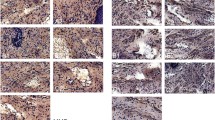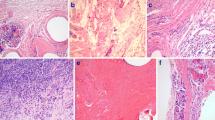Abstract
Introduction and hypothesis
This paper aims to study the vesicovaginal space local tissue reaction to type I and II polypropylene mesh in a rabbit model.
Methods
Different types of meshes were implanted into the rabbit vesicovaginal space. The animals were killed at days 7 and 60, and the initial implant and the neighboring host tissue were removed, including the bladder and vaginal wall. Histopathology and immunohistochemistry (Ki-67 and proliferating cell nuclear antigen) were performed to evaluate the cell proliferation, and the indirect local inflammatory response was described.
Results
One rabbit had erosion at the urinary bladder mucous membrane, which resulted in vesical stone formation in the type I mesh group at day 60. Obvious local tissue reaction was found after the different types of meshes were implanted, and the reaction tapered and disappeared over time. At day 7, the reaction in the type I mesh group was stronger than that in the type II group, while at day 60, the reaction shows no difference.
Conclusion
The two types of meshes could induce local tissue reaction, but this was stronger in type I mesh group at day 7 and shows no obvious difference between the two groups at day 60.







Similar content being viewed by others

References
Olsen AL, Smith VJ, Bergstrom JO et al (1997) Epidemiology of surgically managed pelvic organ prolapse and urinary incontinence. Obstet Gynecol 87:501–506
Boyles SH, Weber AM, Meyn L (2003) Procedures for pelvic organ prolapse in the United States 1979–1997. Am J Obstet Gynecol 188:108–115
Sivaslioglu AA, Unlubilgin E, Dolen I (2008) A randomized comparison of polypropylene mesh surgery with site-specific surgery in the treatment of cystocoele. Int Urogynecol J 19:467–471
Novara G, Artibani W (2005) Surgery for pelvic organ prolapse: current status and future perspectives. Curr Opin Urol 15:256–262
Fox SD, Stanton SL (2000) Vault prolapse and rectocele: assessment of repair using sacrocolpopexy with mesh interposition. BJOG 107:1371–1375
Karlovsky ME, Thakre AA, Rastinehad A et al (2005) Biomaterials for pelvic floor reconstruction. Urology 66:469–475
Parekh MH, Minassian VA, Poplawsky D (2006) Bilateral bladder erosion of a transobturator tape mesh. Obstet Gynecol 108(3 Pt 2):713–715
Mustafa M, Wadie BS (2007) Bladder erosion of tension-free vaginal tape presented as vesical stone; management and review of literature. Int Urol Nephrol 39(2):453–455
Krause H, Bennett M, Forwood M et al (2008) Biomechanical properties of raw meshes used in pelvic floor reconstruction. Int Urogynecol J 19:1677–1681
Boulanger L, Boukerrou M, Rubod C et al (2008) Development of an animal model to study meshes used in genital prolapse surgery. Eur J Obstet Gynecol Reprod Biol 136:254–259
Rechberger T, Jankiewicz K, Adamiak A et al (2009) Do preoperative cytokine levels offer a prognostic factor for polypropylene mesh erosion after suburethral sling surgery for stress urinary incontinence? Int Urogynecol J 20:69–74
Klosterhalfen B, Klinge U, Schumpelick V (1998) Functional and morphological evaluation of different polypropylene-mesh modifications for abdominal wall repair. Biomaterials 19:2235–2246
van Kooten TG, Klein CL, Kirkpatrick CJ (2000) Cell-cycle control in cell-biomaterial interactions: expression of p53 and Ki67 in human umbilical vein endothelial cells in direct contact and extract testing of biomaterials. Biomed Mater Res 52(1):199–209
Conflicts of interest
None.
Author information
Authors and Affiliations
Corresponding authors
Rights and permissions
About this article
Cite this article
Zhang, K., Han, J., Yao, Y. et al. Local reaction to the different meshes at the vesicovaginal space in rabbit model. Int Urogynecol J 23, 605–611 (2012). https://doi.org/10.1007/s00192-011-1612-z
Received:
Accepted:
Published:
Issue Date:
DOI: https://doi.org/10.1007/s00192-011-1612-z



